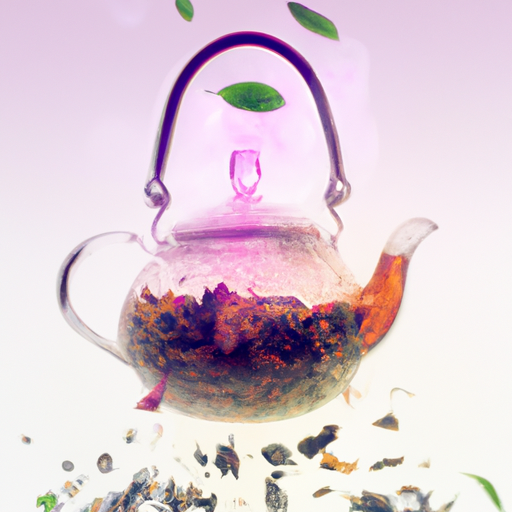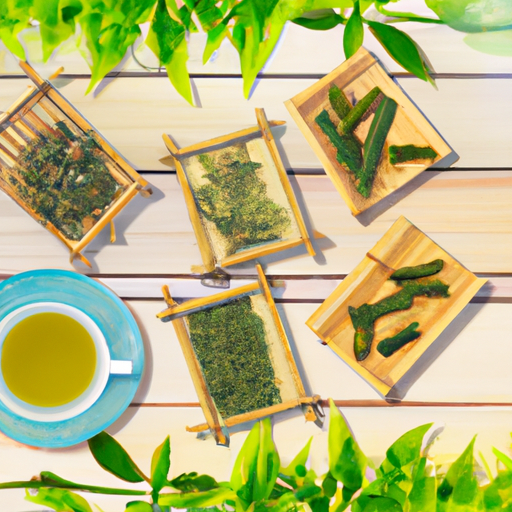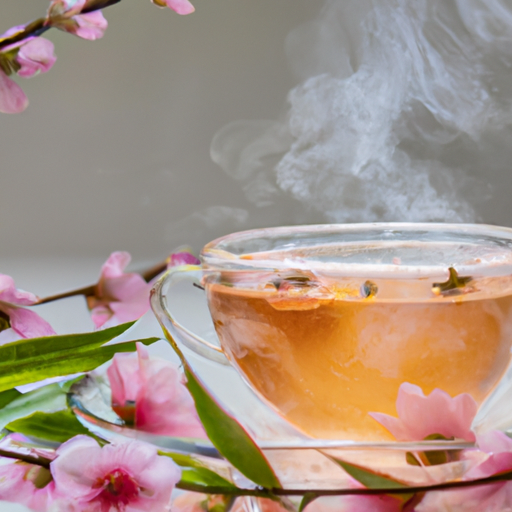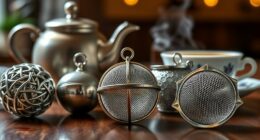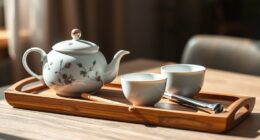Steeping herbal tea is akin to discovering a secret realm of flavors and scents. It involves a gentle procedure that demands precise timing to reach an ideal equilibrium.
Now, you may be wondering, how long do you let herbal tea steep? Well, get ready to be amazed because the answer might surprise you. Steeping time is not just a matter of minutes, it’s a journey of exploration and discovery.
In this article, I will guide you through the enchanting world of herbal tea steeping. We will delve into the art of finding the ideal steeping time for different herbal teas, and even experiment with various durations to uncover the hidden depths of flavors.
Along the way, I will share some valuable tips and techniques to enhance your herbal tea experience.
So, grab your favorite herbal tea blend, and let’s embark on a steeping adventure like no other. Get ready to savor every sip and indulge in the captivating flavors that await you.
Let’s dive into the fascinating world of herbal tea steeping and unlock the secrets that lie within.
Key Takeaways
- The general rule of thumb for steeping herbal teas is about 5-7 minutes, but some teas may require longer steeping times.
- Different herbs have different optimal steeping times, with chamomile and peppermint benefiting from longer steeping times of 7-10 minutes, while lavender and rosehip only need 3-5 minutes to avoid bitterness.
- The optimal temperature for steeping herbal tea is between 195°F – 205°F, and using filtered or spring water can ensure a clean and fresh taste.
- Steeping time can greatly impact the flavor of herbal tea, with shorter steeping times resulting in lighter and more delicate flavors, while longer steeping times intensify the flavor and bring out herbal notes.
Understanding Herbal Tea Steeping Time
When it comes to brewing herbal tea, it’s crucial to know the perfect amount of time to let it steep in order to unlock its full flavor and health benefits.
Steeping time can vary depending on the type of herbal tea and personal preference. However, a general rule of thumb is to steep herbal teas for about 5-7 minutes. This allows the flavors and essential oils to fully infuse into the water, resulting in a rich and aromatic cup of tea.
It’s important to note that some herbal teas might require longer steeping times to bring out their full potential. For example, certain herbal teas with stronger flavors, like chamomile or peppermint, can benefit from longer steeping times of around 10 minutes.
Experimenting with different steeping times and temperatures can help you find the perfect balance of flavor and strength for your herbal tea.
Moving on to experimenting with steeping time, let’s explore how it can affect the taste and benefits of your brew.
Experimenting with Steeping Time
After a brief steeping, the herbal infusion releases its full flavor, filling the air with the enticing aroma of a garden in bloom. The world of herbal tea is vast, and exploring different herbs can be an exciting journey.
One of the ways I’ve been experimenting with herbal tea is by varying the steeping time. I’ve found that some herbs, like chamomile and peppermint, benefit from a longer steeping time of around 7-10 minutes. This allows the flavors to fully develop and creates a more robust and satisfying cup of tea.
On the other hand, delicate herbs like lavender and rosehip only need a shorter steeping time of 3-5 minutes to avoid any bitterness. By adjusting the steeping time, I’ve been able to unlock the unique flavors and benefits of each herb.
Now, let’s move on to some tips for steeping herbal tea.
Tips for Steeping Herbal Tea
To get the most out of your herbal infusion, try these helpful tips for steeping. Understanding the optimal temperature and experimenting with different water types can make a significant difference in the flavor and effectiveness of your herbal tea.
| Optimal Temperature | Different Water Types |
|---|---|
| 195°F – 205°F | Filtered |
| Spring | |
| Distilled | |
| Mineral |
Steeping your herbal tea at the right temperature allows for the extraction of its beneficial compounds while preserving its delicate flavors. Using filtered or spring water ensures a clean and fresh taste, while distilled water can provide a purer infusion. Mineral water adds a unique touch, enhancing the taste profile of certain herbal teas.
Now that you understand the importance of temperature and water types, let’s delve into the next section, where we’ll guide you through the optimal herbal tea steeping time.
Herbal Tea Steeping Time Guide
When it comes to steeping herbal teas, it’s important to know the optimal steeping times for different types of teas. In this discussion, I’ll provide a guide on the steeping times for popular herbal teas, blended herbal teas, and custom herbal tea blends.
By understanding these steeping times, you can ensure that you achieve the best flavor and health benefits from your herbal tea.
Steeping Times for Popular Herbal Teas
For the perfect cup of herbal tea, let it steep just long enough to release its full flavor and aroma. Understanding herbal tea flavors is key to determining the ideal steeping time for each type. Some herbal teas, such as chamomile and peppermint, have delicate flavors that can be easily overwhelmed by longer steeping times. However, other herbal teas, like hibiscus and ginger, benefit from a longer steeping time to extract their bold and robust flavors. Additionally, the benefits of longer steeping time go beyond flavor. It can also enhance the potential health benefits of the tea, allowing more of the beneficial compounds to be extracted. To help you find the perfect steeping time, refer to the table below:
| Herbal Tea | Steeping Time |
|---|---|
| Chamomile | 5-7 minutes |
| Peppermint | 3-5 minutes |
| Hibiscus | 7-10 minutes |
| Ginger | 7-10 minutes |
| Rooibos | 5-7 minutes |
| Lemon Balm | 5-7 minutes |
Now, let’s move on to exploring the steeping times for blended herbal teas.
Steeping Times for Blended Herbal Teas
Blended herbal teas require careful attention to steeping times in order to fully enhance their unique flavors and aromas. Understanding infusion methods is key to achieving the perfect cup.
Here are a few tips to help you get the most out of your blended herbal tea:
-
Experiment with different steeping times: Blended herbal teas often contain a variety of ingredients, each with its own optimal infusion time. By trying different steeping times, you can find the perfect balance of flavors.
-
Longer steeping for stronger flavors: Some blended herbal teas benefit from a longer steeping time. This allows the flavors to fully develop and creates a bolder, more robust cup of tea.
-
Don’t oversteep delicate blends: On the other hand, some blended herbal teas are more delicate and can become bitter if steeped for too long. Be sure to follow the recommended steeping time to avoid any unwanted bitterness.
By understanding infusion methods and experimenting with different steeping times, you can unlock the full potential of your blended herbal teas.
Now, let’s move on to exploring steeping times for custom herbal tea blends.
Steeping Times for Custom Herbal Tea Blends
Discover the secret to unlocking the perfect infusion time for your very own custom tea blends and savor a symphony of flavors that’ll delight your taste buds.
When it comes to custom herbal tea blends, understanding the infusion process is key to achieving the optimal taste and health benefits. Each herb has its own unique properties and requires a specific amount of time to release its flavors and beneficial compounds.
For example, delicate herbs like chamomile and lavender should steep for about 5-7 minutes, while stronger herbs like peppermint and ginger may need 7-10 minutes. By allowing your custom blend to steep for the right amount of time, you can ensure a well-balanced and flavorful cup of herbal tea.
Now, let’s explore how you can enhance your herbal tea experience by adding natural sweeteners or incorporating mindfulness techniques.
Enhancing Your Herbal Tea Experience
To truly amp up your herbal tea experience, try steeping it for a little longer than usual—you won’t believe the difference it makes!
Steeping herbal tea for an extended period allows the flavors to fully develop and infuse into the water, resulting in a richer and more robust taste. Not only does this enhance the overall flavor profile, but it also unlocks the full potential of the herbs’ natural properties, maximizing the health benefits you can reap from your tea.
Steeping herbal tea for a longer time also allows you to experiment and explore different flavor combinations. By adjusting the steeping time, you can create a personalized tea blend that suits your taste preferences.
Now, let’s delve into the fascinating world of exploring traditional herbal tea steeping practices.
Exploring Traditional Herbal Tea Steeping Practices
When exploring traditional herbal tea steeping practices, there are several key points to consider.
One important aspect is the cultural differences in steeping time, as different cultures have their own unique preferences and traditions.
Additionally, historical practices and rituals surrounding herbal tea steeping can provide valuable insights into the art of tea making.
Lastly, learning from traditional herbal tea experts can offer a wealth of knowledge and expertise in achieving the perfect cup of tea.
Cultural Differences in Steeping Time
In various cultures, the steeping time for herbal tea can vary widely. Cultural preferences play a significant role in determining the ideal steeping time, as it can greatly impact the flavor of the tea. For example, in Chinese culture, tea is often steeped for shorter periods to preserve its delicate flavors. On the other hand, in Indian culture, herbal teas are commonly steeped for longer durations to extract the maximum flavor and medicinal properties. To provide a clearer understanding, here is a table showcasing the steeping times for herbal tea in different cultures:
| Culture | Steeping Time |
|---|---|
| Chinese | 2-3 minutes |
| Indian | 5-10 minutes |
| Moroccan | 15-20 minutes |
| Japanese | 1-2 minutes |
These cultural differences in steeping time highlight the diverse approach to enjoying herbal tea worldwide. Moving forward, let’s delve into the historical practices and rituals associated with herbal tea consumption.
Historical Practices and Rituals
Discover fascinating historical practices and rituals surrounding herbal tea consumption, where cultures worldwide have embraced this ancient beverage for centuries.
Did you know that in ancient China, tea was considered a sacred plant and only consumed by Buddhist monks and nobility?
The historical significance of herbal tea cannot be overstated, as it has played a vital role in various cultural ceremonies and traditions.
From Japanese tea ceremonies to Moroccan mint tea rituals, the act of preparing and serving herbal tea has been a symbol of hospitality, respect, and spiritual connection.
Beyond its cultural significance, herbal tea has also been valued for its numerous health benefits.
Rich in antioxidants, vitamins, and minerals, herbal teas have been used for centuries to alleviate ailments and promote overall well-being.
By exploring the historical practices and rituals surrounding herbal tea, we can learn from traditional experts and deepen our appreciation for this ancient beverage.
Learning from Traditional Herbal Tea Experts
Having explored the historical practices and rituals surrounding herbal tea, it is now time to delve into the wisdom of traditional herbal tea experts and learn from their techniques. These experts have spent years perfecting their craft, passing down knowledge from one generation to another. By understanding their methods, we can enhance our own tea steeping experience and fully appreciate the health benefits that herbal teas offer.
To help you grasp the essence of traditional herbal tea techniques, I have prepared a table that showcases some of the most effective methods used by experts around the world. This table will provide you with a concise overview of various techniques, such as water temperature, steeping time, and recommended herbal teas for specific health concerns. By following these guidelines, you can ensure that your herbal tea is steeped to perfection, maximizing its flavor and medicinal properties.
Now, let’s examine the table below to learn from the experts and unlock the secrets of herbal tea steeping:
| Technique | Water Temperature | Steeping Time | Recommended Herbal Tea |
|---|---|---|---|
| Technique 1 | 90°C (194°F) | 5 minutes | Chamomile |
| Technique 2 | 80°C (176°F) | 4 minutes | Peppermint |
| Technique 3 | 95°C (203°F) | 6 minutes | Ginger |
| Technique 4 | 85°C (185°F) | 3 minutes | Lavender |
By incorporating these techniques into your herbal tea preparation, you can elevate your tea-drinking experience and reap the full range of health benefits. Now, let’s move on to the conclusion and final thoughts, where we will summarize our findings and explore additional insights on herbal tea steeping.
Conclusion and Final Thoughts
Ultimately, the final decision on how long to let herbal tea steep is up to personal preference and taste. However, it’s important to note that steeping time can have a significant impact on the flavor profile of the tea. Exploring alternative steeping methods can provide a unique and enjoyable tea experience.
One method is a shorter steeping time, which can result in a lighter and more delicate flavor. On the other hand, a longer steeping time can intensify the flavor and bring out the herbal notes in the tea. It’s also worth experimenting with different temperatures of water, as this can further influence the taste of the tea.
Overall, finding the perfect steeping time for herbal tea is a journey of taste exploration and personal preference.
Frequently Asked Questions
What are some common mistakes to avoid when steeping herbal tea?
When steeping herbal tea, it’s important to avoid common mistakes to achieve the optimal steeping time. Rushing the process can result in a weak flavor, while over-steeping can make it bitter.
Can I reuse the herbs from my first steeping to make a second cup of tea?
Yes, you can reuse the herbs from your first steeping to make a second cup of tea. By doing so, you can maximize the flavor and get the most out of your herbs.
Are there any herbal teas that require longer steeping times than others?
Some herbal teas benefit from a longer steeping time, which enhances their flavors. It’s important to experiment and find the right balance, as prolonged steeping can sometimes result in a bitter taste.
Is it possible to oversteep herbal tea? What are the consequences?
Oversteeping herbal tea can result in a bitter, unpleasant taste and a loss of the tea’s beneficial properties. It is important to follow the recommended steeping time to avoid these consequences.
Can I use a tea infuser to steep herbal tea, or are there other preferred methods?
When it comes to steeping herbal tea, using a tea infuser is a popular choice. However, there are alternative methods you can explore as well. Let me guide you through the various options available.
Conclusion
In conclusion, my dear tea enthusiasts, the art of herbal tea steeping isn’t to be taken lightly. It requires patience, precision, and a touch of whimsy.
As we’ve learned through our journey, the perfect steeping time can vary depending on the type of herbal tea and personal preference. So go forth, my friends, and experiment with the alchemy of steeping. But remember, don’t let it steep for too long, unless you wish to summon the ancient tea spirits and risk being transported to a parallel tea universe.
Happy steeping!

